You are in a lush forest. Sunlight filters through the bright green canopy, casting dappled shadows on the ground. Towering trees rise over delicate ferns, wildflowers, and colorful mushrooms. A deer slinks behind a shrub. But there are subtle signs of human intervention: small electronic devices gathering vital data on potential threats such as drought or pests and transmitting them miles away.
Although technology has long been used to study animals and plants in forests, it’s evolving rapidly—becoming smaller, smarter, and more interconnected. Some devices are so small they can be placed on a single leaf. “For developers of such devices, the forest presents a completely new challenge,” says Ulrike Wallrabe, a professor specializing in micro-scale technology. Here, tech must withstand ever-changing conditions, from fluctuating temperatures to rain and snowfall, and even insects.
Once up and running, the new generation of smart devices will offer unprecedented insights into the forest. “Drones already monitor large areas of forest, but they cannot explain why one tree is thriving and another is struggling,” says Wallrabe. “We need to understand what’s happening on a small scale and over time.”
Wallrabe and her fellow researchers are working on a range of devices that will be deployed from the ground to the treetops, transmitting data from Germany’s Black Forest to their labs at the University of Freiburg. At the same time, private sector scientists and engineers are also focused on making their devices unobtrusive and, ultimately, self-sustaining.
Silvanet Wildfire Sensor
Time is of the essence when fighting forest fires. Sensors attached to trunks “smell” tell-tale gases like hydrogen and carbon monoxide, and alert firefighters within the first hour—before satellites or cameras can spot open flames. German startup Dryad Networks has built AI into its solar-powered sensors to ensure that they can distinguish between real fires and, say, passing diesel trucks.
Treevia
Digital dendrometers relieve foresters of tedious work. As trees grow, the elastic band wrapped around their trunk stretches and transmits data directly to a computer. The lightweight device from Brazilian startup Treevia can even be attached to saplings. It also contains a humidity and heat sensor, providing insights into climatic impacts on reforested areas.
The Guardian
What does it take to catch illegal loggers or poachers? A smartphone is a good start. Rainforest Connection’s recycled, solar-powered smartphone listens for the sound of chain saws or gunshots within a 1-mile radius. The recordings are transmitted to the cloud for analysis and alert local authorities in near real time. This device also provides insights into the distribution and calling behavior of animals.
BiodivX Drone
As animals move through trees, they shed DNA through feces, skin, and hair. This innovative drone collects what is known as environmental DNA (eDNA) from leaves and branches—with particles sticking to its adhesive strips. Scientists from Switzerland programmed the drone so it can navigate autonomously through dense forests and hover steadily around branches to take samples.
Leaf Sensor
Wallrabe and her team at the University of Freiburg have developed a sensor that measures gas exchange between a leaf and its surroundings. It can detect stress-related chemicals that trees emit under stress in the event of a drought or infestation. The capsule is transparent so that sunlight can reach the leaf without impairing its function.
Plant-e
When sunlight is limited, most devices are powered by batteries. Plant-e, a Dutch company spun out of Wageningen University, powers its sensors instead by electrons which are released when bacteria break down organic matter in the soil around plants.
Seed-dropping drones
To scale up and accelerate tree planting efforts, several companies, including UK-based Dendra Systems, have developed cutting-edge drones. These drones, loaded with an array of seeds, hover over remote areas and release their precious cargo. This is particularly helpful in remote areas that are difficult for humans to access. By recording the exact location of drop sites, foresters can monitor the growth and health of the newly planted trees.
This article appears in the January/February 2025 issue of WIRED UK magazine.









